Seared Bacon-crusted Albacore Tenderloin with Pomegranate Reduction
The ocean-fishing charter outfit that Charles and I use out of Depoe Bay has walls lined with pictures of clients and their catch of chinook salmon, steelhead, rockfish and albacore tuna. Rows and rows of albacore tuna.
Before moving to Oregon, I’d cooked and eaten yellowfin tuna many times but had never cooked or tasted albacore, or so I thought. It turns out that canned supermarket tuna is processed albacore. Charles and I hope to one day catch albacore off Oregon’s coast ourselves, but at more than $200 per person for the charter, it’s still a dream. The reason it’s so expensive compared to going salmon fishing or bottom fishing (at about $80 per person) is that the albacore are forty to fifty miles off our coast and it takes nearly two hours to get out there. An albacore fishing trip is a twelve-hour commitment, and the boat is constantly moving or trolling so that the bait moves through the waters, hence you really burn a lot of fuel out there in the deep blue. We asked one of our personal chef friends about albacore and what people do with fresh-caught albacore, as we were dreaming about one day going fishing for them, and she lit up. “Oh, once you taste fresh albacore, you’ll never eat another can of ‘Chicken of the Sea,'” a moniker used by one of the canned tuna companies. Fresh-caught tuna is either home-canned or vacuum-packed and frozen, she said. If we ever went out on a tuna fishing trip, she would teach us how to can tuna in return for a fish…or two, she said, her eyes sparkling.
Albacore can weigh anywhere from 20 to 30 pounds each and can reach 99 pounds. And the Oregon limit is 25 tuna per person, so that’s a lot of tuna! The folks at Dockside Charters told me the albacore run off the Oregon coast is usually from July through September. According to the National Oceanic and Atmospheric Administration’s National Marine Fisheries Service, most of the albacore tuna consumed in the U.S. are caught off the shores of Oregon and Washington. Much of this catch is exported to foreign markets, including Spain, Japan and Canada. The rest is sold in U.S. markets, along with imported albacore, primarily from Thailand and Indonesia. Pacific albacore is a highly migratory fish and moves throughout large areas of the Pacific. To read more about albacore from NOAA National Marine Fisheries Service, click here.
Here in Oregon, you can find fresh albacore at supermarkets in steaks or loins, long strips of muscle. A tuna will yield four loins, long strips of flesh that run down the lengths of their bodies. If you’re on the Oregon coast, you can also buy whole albacore straight off the boats in many of the ports. During our first trip to Newport, we noticed boats by the docks, with signs touting “Fresh Albacore,” and we went to see for ourselves. Sure enough, they were iced down in large blue plastic containers. One of the deckhands opened a lid for us, and the fish were still gleaming through the ice. Our favorite sports-fishing captain, Loren Goddard, told us you need to be careful when buying whole tuna off the boats to make sure that the fish has been bled properly. When asked what he meant, he explained that after the fish is caught, it should be drained of blood before being iced down or the flavor will be “off.” Properly bleeding tuna will preserve its light-colored flesh and produce milder flavor.
According to K.S. Hilderbrand, Jr., a former Sea Grant Extension seafood processing specialist with Oregon State University, tuna are caught by hooks or with nets. In the Northwest, albacore usually are landed by troll boats, which rapidly pull (or troll) 10 to 20 lines through the water. Albacore trollers preserve the fish with either ice or mechanical refrigeration because albacore most often are found 50 or more miles from shore — a distance that forces the boats to stay out several days at a time.
Top-quality fish are alive when landed and are bled immediately. Bleeding produces a lighter-colored, milder-flavored flesh. After the fish are bled, they are packed in ice or refrigerated as soon as possible.
Chilling the fish immediately is sometimes not possible because of fishing conditions, but quality fish are iced or refrigerated within an hour of capture. At this point, the albacore are either chilled or frozen.
Chilling means the fish are kept near 32 °F, but the flesh is not allowed to freeze. Frozen means the fish are kept at subfreezing temperatures until they are sold at the dock.
Once the chilling or freezing process begins, the real battle to maintain fish quality is under way. Quality loss while the fish are in the refrigeration system depends on the type of refrigeration used-and quality loss often can’t be determined by inspecting the outer appearance of the fish. Here are some tips that Hilderbrand offers in one of the OSU Sea Grant publications:
- High-quality fresh tuna will have a characteristic odor that’s fishy but not strongly so. Generally, the eyes will be clear. The skin will not be overly slimy. The gills will have a deep red color rather than a brownish pink. The sides of the fish should be silvery rather than dull gray. There should be plenty of ice left on the fish and in the hold of the boat.
- The temperature inside the fish should be 32 °F or less from boats using either ice or chilled seawater. Bled fish may have an inconspicuous cut behind the chin. In no case should the fish be more than five or six days out of the water for top quality.
- The flesh of top-quality, bled fish will not have external dents or internal bruise marks and blood spots. The flesh will remain characteristically white and have a pleasant odor when cooked.
- Even good-quality tuna cooked with the skin on usually will have a characteristically unpleasant “tuna fish” odor.
- A boat may have fish that vary in the time they have been out of the water, so be sure to examine the fish and ask questions. Don’t be afraid to reject the fish if you question its quality.
- Do not buy tuna that is over 40 °F. Fishers selling quality tuna will have a thermometer and will not mind showing you that the fish is at 40 °F or less. Fish held for extended periods at temperatures higher than 40 °F can become a safety risk. Histamine, which is a toxin, forms from naturally occurring amino acids in tuna and tunalike species. Histamine can cause mild to severe allergic reactions in susceptible people.
To read more about Oregon’s albacore fishery from OSU, click here.
Well, enough about the science of the fish and tips on buying off the boat. I was craving albacore so I visited our fishmonger yesterday. They had tuna loin that was fresh from one of the boats in Newport at about $7 a pound, and I asked him to cut three nice pieces about two inches thick from one of the loins. I also asked him to gently remove the skin so the loins would be intact. He asked how I was going to prepare them, and I told him about being served tuna at a now-defunct restaurant in Baltimore where it had been rolled in bacon bits and then seared. He said it sounded delicious and told me not to be afraid to serve the albacore with the centers pink as these were fresh fish. Tuna cooks very quickly, he said.
The idea of pairing bacon and fish had never occurred to me until Charles and I had tasted the fillet mignon of ahi encrusted with bacon at Atlantic restaurant in Baltimore. We asked Spike, the chef at the restaurant, his technique for getting the bits of bacon to adhere to the ahi steak. The secret was a wash of egg whites, he told us. The memory of that dish has struck with me. Charles has cooked this before and will be adapting the recipe for salmon to share in an upcoming blog post.
This is a great dish to serve for a light dinner on a bed of greens. I made some homemade refrigerator pickles to serve on the side, and a pomegranate, red wine and balsamic reduction to dress the fish and greens. POM Wonderful pomegranate juice is widely available and adds a wonderfully bright and fruity flavor to the reduction.
Seared bacon-crusted albacore tenderloin, served on watercress with a balsamic red wine and pomegranate reduction, and homemade refrigerator pickles on the side.
Seared Bacon-crusted Albacore Tenderloin with Pomegranate Reduction
For the sauce:
- 2 cups (480 ml.) red wine
- 1½ cups (360 ml.) POM pomegranate juice
- ¼ cup (60 ml.) balsamic vinegar
- 1 tablespoon (15 ml.) extra virgin olive oil
- Combine first three ingredients in a saucepan and reduce over a low flame to half its volume and set aside until ready to serve.
- When ready to serve, whisk in olive oil before drizzling over fish and greens.
For the albacore:
- One 2-inch-thick piece of albacore tuna loin per person
- One strip of apple wood-smoked bacon per piece of tuna
- 1 tablespoon (15 ml.) peanut oil
- Watercress, radish sprouts, sunflower sprouts, or any other micro-green or spring salad mix that you like
- White from one egg
- In a cast-iron skillet, heat the oil over medium heat and cook bacon strips until brown and crispy.
- Turn off the flame and keep the bacon fat in the pan; drain bacon in paper towels and set aside to cool.
- When bacon has cooled, break into pieces into a blender and blend at high speed until completely pulverized, then empty bacon onto a flat plate.
- In a bowl, beat the egg white then brush the sides of the albacore loin with egg white and gently roll in bacon, taking care to cover the sides of the loin with as many bacon bits as possible. Reserve remaining bacon bits.
- Turn your oven broiler to high and position the topmost rack about three to four inches from the top.
- Over a high flame, heat the cast-iron skillet that you cooked the bacon in, along with the reserved bacon fat, and gently place each albacore loin medallion into the skillet, then place the skillet into the oven.
- Broil for 3 minutes, remove the skillet and gently turn over albacore medallions, taking care not to knock off bacon bits.
- Place skillet back under broiler for 3 more minutes to sear the other side.
- Prepare individual serving plates with a small mound of micro-greens or salad mix and gently set one albacore medallion on each mound of greens.
- Whisk the olive oil into the pomegranate reduction and drizzle a little onto each medallion and mound of greens.
- Top off each medallion with the remaining reserved bacon bits and serve.
Enjoy!
— Vic
Category: Seafood
About the Author (Author Profile)
Victor Panichkul is a journalist and writer by training; a cook, wine lover and photographer by passion; and a lover of the outdoors since moving to Oregon more than 10 years ago. He is a native of Bangkok, Thailand.






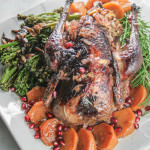

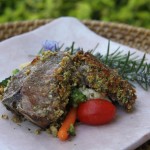

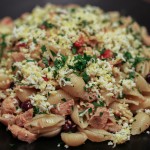


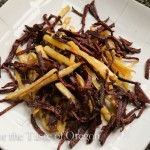


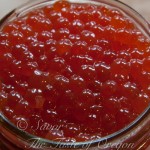


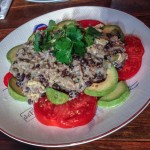

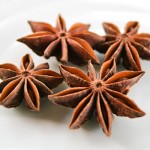



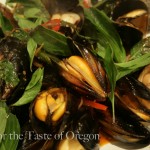



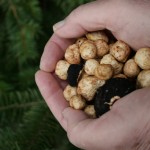
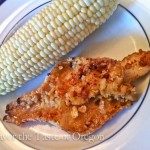


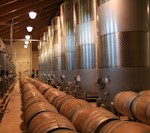
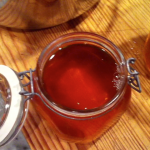











Yumeee! Vic will have to work hard to top this, possibly one of his best meals. It’s true, fresh albacore leaves commercially canned tuna in the dust.
[…] During our 7 year stint in Baltimore, we often dined at Atlantic, a seafood restaurant under the helm of Chef Spike Gjerde. In the midst of other stellar entrees, he served a spectacular “Filet Mignon of Tuna with a Red Wine Reduction” that seduced me on my first visit. As a matter of fact, I never ordered anything else and depended on the kindness of my fellow diners for samples of the rest of his menu. The last time I was there, I praised the chef on this dish and also quizzed him about his technique which he graciously shared. The method I am referencing is coating the filet in crisply cooked and finely chopped bacon. A little beaten egg white standing in as “glue” is the trick. Vic utilizes this method in the post featuring Seared Bacon Crusted Albacore Tenderloin with Pomegranate Reduction. […]